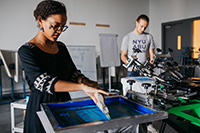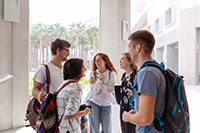Could giant cell phone towers soon be a thing of the past?
Engineers are exploring ways that device-to-device communication between mobile phones could provide faster service, and even put extra money in the pockets of those willing to share their data with others nearby.
Currently, cell phone traffic has to go through a tower, or base station, which can lead to disconnected calls and weak internet connections when there are too many users in the area or you're too far away from the tower, like in a tunnel or basement.
"Our model proposes device-to-device (D2D) communication channels to transmit data in short-range interactions," said Jian Gao, NYU Abu Dhabi PhD candidate in engineering, which would eliminate the need to transmit information through the tower.
D2D technology is sophisticated and complex but the concept is fairly simple: it works similar to personal hotspots shared between individuals. The engineers call the process of data-sharing between phones crowdforwarding.
For customers, D2D communication reinforces data connectivity and for operators like Etisalat, their traffic load is reduced, which means less investment is required to maintain base station infrastructure.
For example, “Etisalat currently provides the 4G network in the UAE through big mobile phone towers,” Gao said. “When person A makes a phone call, the signal goes through these towers to reach person B. With a growing population, Etisalat needs to build more towers to provide a quality connection. To cover the cost, person A is charged for making a call. This type of transmission is a waste of resources if person B is physically in the area.”
Instead of base stations, Gao's model proposes using local devices — person C — to transmit the data, and importantly, to incentivize person C to share.
"Imagine that when person A wants to send data, there are 100 candidates offering to help. Compared with only one candidate, A has many more choices and can therefore get better service and pay less money. In the 4G network, increasing users (the crowd) will cause slower network speed. But in our model, the crowd plays a positive role.”
To enhance mobile service, we need more routers to forward data. Instead of building more base stations, the operator can develop the potential of device-to-device communication. In such a network, each user can be a temporary router and forward data to others. The operator could design a reward policy to encourage mutual support between users.
Incentive to share data
Incentives are a critical part of the model, Gao said, because if the system has a good incentive policy there will be enough users encouraged to forward data. In theory, the more crowded a city is, the better mobile service it will have.”
In the crowdforwarding network model, he said, each person’s phone is like a temporary router and those who share their data would be rewarded for it, either paid by the individual using it or paid by the cell phone company.
Also, “we think the service providers can give discounts to encourage forwarding behaviors and decrease data traffic load on the network,” said Gao, then they would only need to build towers in rural areas.
But the model isn’t perfect, yet.
Crowdforwarding uses a lot of data and battery life, at a potential cost. “It's reasonable that people would switch off their hotspots, especially if there is no incentive to have it on,” he concluded.
Information security is also problem because the data goes through other users. “The next part of our work is to figure out how to keep the network away from attackers and viruses,” he said.
Gao presented the research at an international conference on communications and mobile technology and won the Best Paper Award.


